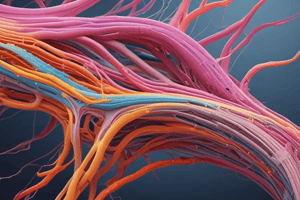Podcast
Questions and Answers
What effect does the unbinding of Ca2+ from calmodulin (CaM) have on MLCK?
What effect does the unbinding of Ca2+ from calmodulin (CaM) have on MLCK?
- It increases the activity of MLCK.
- It deactivates MLCK. (correct)
- It activates MLCK permanently.
- It has no effect on MLCK.
What role does myosin phosphatase play in muscle contraction?
What role does myosin phosphatase play in muscle contraction?
- It binds to myosin to enhance ATPase activity.
- It increases the concentration of calcium ions.
- It activates MLCK to promote contraction.
- It removes phosphate from myosin, decreasing its activity. (correct)
How does decreased myosin ATPase activity affect muscle tension?
How does decreased myosin ATPase activity affect muscle tension?
- It keeps muscle tension unchanged.
- It increases muscle tension.
- It leads to decreased muscle tension. (correct)
- It causes muscle tension to fluctuate unpredictably.
What is the effect of calcium ions (Ca2+) on calmodulin (CaM)?
What is the effect of calcium ions (Ca2+) on calmodulin (CaM)?
What is a direct result of increased myosin phosphorylation?
What is a direct result of increased myosin phosphorylation?
What are the characteristics of slow oxidative muscle fibers?
What are the characteristics of slow oxidative muscle fibers?
Which motor unit is associated with the smallest muscle fibers?
Which motor unit is associated with the smallest muscle fibers?
What is a critical aspect of the order of motor unit recruitment?
What is a critical aspect of the order of motor unit recruitment?
What distinguishes multi-unit smooth muscle from single-unit smooth muscle?
What distinguishes multi-unit smooth muscle from single-unit smooth muscle?
How does calcium contribute to muscle contraction in smooth muscle tissue?
How does calcium contribute to muscle contraction in smooth muscle tissue?
Which muscle type is characterized by being striated and under involuntary control?
Which muscle type is characterized by being striated and under involuntary control?
What is the primary function of myoglobin in muscle fibers?
What is the primary function of myoglobin in muscle fibers?
Which type of smooth muscle typically exhibits pacemaker potentials?
Which type of smooth muscle typically exhibits pacemaker potentials?
What is the role of varicosities in smooth muscle contraction?
What is the role of varicosities in smooth muscle contraction?
What best describes the function of fast glycolytic muscle fibers?
What best describes the function of fast glycolytic muscle fibers?
How do the calcium pumps in different muscle fiber types vary?
How do the calcium pumps in different muscle fiber types vary?
What effect does the unstable membrane potential in smooth muscle cells have?
What effect does the unstable membrane potential in smooth muscle cells have?
Which factor does NOT influence the recruitment of muscle fibers during contraction?
Which factor does NOT influence the recruitment of muscle fibers during contraction?
In terms of endurance, which muscle fiber type exhibits the highest resistance to fatigue?
In terms of endurance, which muscle fiber type exhibits the highest resistance to fatigue?
Flashcards are hidden until you start studying
Study Notes
Motor Unit Recruitment
- Motor unit: comprises a single motor neuron and all the muscle fibers innervated by it
- Motor unit recruitment follows the "size principle": Smaller motor units are recruited first, followed by larger motor units. (Order of recruitment: Small, Intermediate, Large)
- Smaller motor units have slower twitch speeds and are more fatigue resistant due to their higher oxidative capacity. Larger motor units have faster twitch speeds and are less fatigue-resistant due to their high glycolytic capacity.
Muscle Fiber Types
- Slow Oxidative (SO) fibers:
- Slow twitch speed
- High myoglobin content
- High capillary density
- High mitochondrial density
- Fatigue resistant
- Primarily used for sustained, low-intensity activities
- Fast Oxidative (FO) fibers:
- Intermediate twitch speed
- Moderate myoglobin content
- Moderate capillary density
- Moderate mitochondrial density
- Moderately fatigue resistant
- Used for activities requiring both power and endurance
- Fast Glycolytic (FG) fibers:
- Fast twitch speed
- Low myoglobin content
- Low capillary density
- Low mitochondrial density
- Easily fatigued
- Primarily used for short-duration, high-intensity activities
Smooth Muscle
- Characteristics:
- Found in internal organs
- Not striated
- Uninucleated
- Contracts slowly
- Controlled by the autonomic nervous system
- Contractile dynamics:
- Contraction is based on changing cell shape rather than shortening sarcomeres
- Ca2+ signal comes from both the SR (Sarcoplasmic Reticulum) and external sources
- Membrane Potential:
- Unstable, making smooth muscle responsive to various signals
Smooth Muscle Types
- Single-unit:
- Cells are electrically coupled via gap junctions
- Contract as a single unit
- Found in internal organs like the digestive tract
- Multi-unit:
- Cells are not electrically coupled
- Individual cells are innervated
- Allow for fine motor control
- Found in areas like the eye
Calcium Signal in Smooth Muscle
- Sources of Ca2+:
- Ligand-gated calcium channels
- Stretch-activated calcium channels
- Voltage-gated calcium channels
- Sarcoplasmic reticulum (IP3-R)
- Mechanism:
- Ca2+ influx increases intracellular calcium levels
- Leads to activation of myosin light chain kinase (MLCK)
- MLCK phosphorylates myosin
- Phosphorylated myosin interacts with actin
- Resulting in smooth muscle contraction
Membrane Potentials in Smooth Muscle
- Slow wave potentials:
- Oscillations in membrane potential that can trigger action potentials
- Observed in smooth muscle tissues like the digestive tract
- Pacemaker potentials:
- Spontaneous depolarizations that generate rhythmic contractions
- Found in tissues like the heart
Relaxation in Smooth Muscle
- Mechanism:
- Ca2+ is pumped out of the cytosol by various pumps
- Ca2+ unbinds from calmodulin (CaM)
- Myosin phosphatase removes phosphate from myosin
- Myosin light chain kinase (MLCK) activity decreases
- Myosin ATPase activity decreases
- Reduced muscle tension and relaxation occur
Studying That Suits You
Use AI to generate personalized quizzes and flashcards to suit your learning preferences.




